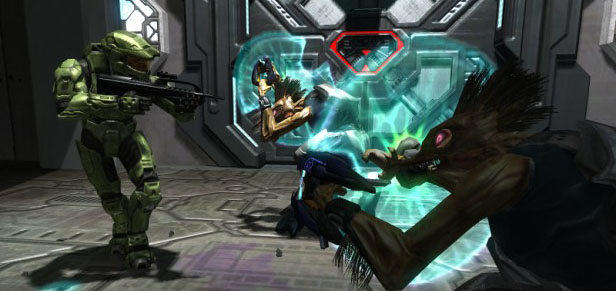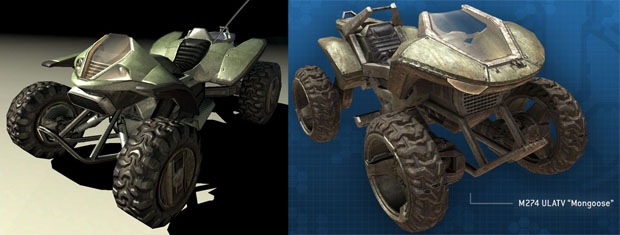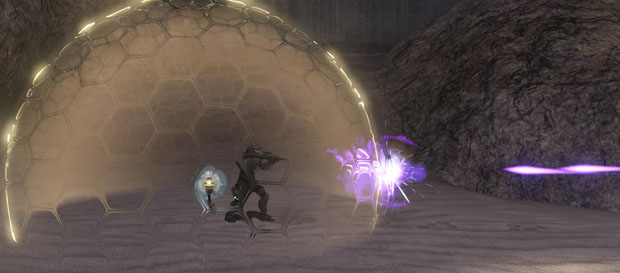Sandbox (Part One)

Defining the Sandbox
Last time we talked, we looked closely at Halo: Combat Evolved and the game’s ability to capture one of the main components of any given encounter: the environment. Of course this doesn’t mean that the first Halo game didn’t have an incredible sandbox or amazing enemies, the other two ingredients which we mentioned. Halo: Combat Evolved’s sandbox was fundamental to the franchise’s success and its enemies were remarkable.
That being said, it is clear that the first Halo game laid the groundwork for an environment’s role within encounters throughout the entire trilogy. In that same regard, Halo 2 was the catalyst for change in the sandbox – a change which became a necessity when considering the scope, scale and opportunities presented in Halo 3. What began in Halo 2 as a complete overhaul of the Halo sandbox ended with Halo 3, in what many believe was a nearly perfect system of tools. Although we’ve talked before about the problematic effect Halo 2’s sandbox changes created for multiplayer, for campaign, the sandbox’s evolution was entirely beneficial, and, in fact, quite necessary.
Without Halo 2, we would not have the Halo 3 we have today.
One might ask then, “What is the sandbox?”
Within the context of this article, we are speaking about the collection of weapons, vehicles, equipment and other implements, both tangible and intangible, which serve as the lifeblood of an encounter. While the environment provides a location and the enemies provide an objective within that location, the weapons and vehicles are essentially the apparatus – the stimulus, as it were – which transforms any given scenario from a potential encounter into an actualized one.
Without the tools of the sandbox, an encounter is only hypothetical. The sandbox materializes it, fleshes it out and goes a step further by defining its intricacies.
And while Halo: Combat Evolved had a fascinating and diverse sandbox with 12 individual weapons and four vehicles, Halo 2’s system set the bar considerably higher. Halo 2 had 19 weapons and seven vehicles, as well as dual-wielding and boarding, elements which added completely new dimensions to the manipulation of the sandbox. In almost every way, Halo 2’s sandbox explosion paved the way for the volumetric increase found in Halo 3’s 26 weapons, 11 vehicles and 11 pieces of equipment.
In hindsight, it’s hard to imagine a more interesting evolutionary pathway for the sandbox from its meager beginnings in Halo: Combat Evolved to the colossal breadth of options found in Halo 3. A close look at the design process and changes which occurred within the sandbox of Halo 2, and subsequently in Halo 3, provide an interesting tale of survival of the fittest, as well as a story of the elaborate refinement of potential.
Darwin’s Halo
Like amino acids in a proteic vat of possibilities, the original base weapons and vehicles fused together the genesis of the trilogy’s sandbox in Halo: Combat Evolved. Simplicity, authenticity and diversity appeared to guide design at every corner. Each weapon and vehicle served its purpose and function – everything was not only compelling to use but completely pragmatic depending on whatever circumstance the player found themselves in. That being said, it was still largely primitive and gaunt.
With Halo 2, however, a number of additions, removals and refinements brought a larger breadth of options to gameplay, even if concerns about specific design choices were not fully resolved until Halo 3. Some of the changes were emphatically needed and others would be questioned even to this day.

Halo 2 introduced the Battle Rifle, a weapon meant to replace the highly-touted and equally-despised M6D Pistol – in the name of balance and plausibility.
The most notable change was the removal of the first game’s Assault Rifle and Pistol, being swapped out for the Submachine Gun and Battle Rifle. While players would never get their hallowed M6D back, with the advent of Halo 3, the new Assault Rifle improved upon its precursor to create what is currently the most accurate mid-range fully automatic weapon in the series.
The scant size of the Covenant sandbox in Halo: Combat Evolved was also considerably amplified in Halo 2. From a fictional standpoint, it might have been confusing to fans initially – the Covenant were alleged to be a powerful war machine which devoured entire planets, yet they only employed three infantry weapons (all short to mid-range), a single grenade and a single turret emplacement. Upon the arrival of Halo 2, we were introduced to a slew of new Covenant weapons, including the Covenant Carbine and the Particle Beam Rifle, distinctive ranged weapons with a Covenant flair. The Fuel-Rod Gun and the Energy Sword, which were once enemy-only weapons, had now become completely useable and compellingly fun at that. It is interesting to note that while many fans railed against the inclusion of the Arbiter’s story and the Covenant-heavy posturing of Halo 2’s campaign, without it, our existing sandbox would be decidedly barren and misshapen.
Halo 2 also brought the addition of two intangible changes to the sandbox which dramatically impacted campaign, as they were not only at the player’s disposal, but also at the enemies’:
- Firstly, the addition of dual-wielding, the ability to hold two one-handed weapons simultaneously – firing and reloading them on an individual basis. In campaign, this became an additional strategic option in the close-quarters combat sections which parsed together the larger environments. While some players eschewed this style for its lack of versatility, its efficacy and pertinence, in appropriate situations, was inarguable.
- Secondly, we see a dramatically altered infantry-to-vehicle combat system. With the inclusion of boarding, players could seize a nearby and relatively slow-moving vehicle, remove the existing operator and take it as their own. Although it is hard to imagine a Halo game without boarding, a quick return to Halo: Combat Evolved shows just how sorely missed this feature would be if removed.
An even closer look at the evolutionary branches of Halo’s vehicles finds several very interesting changes. Halo 2 saw the addition of the Gauss Warthog and the Wraith (unusable in Halo: Combat Evolved), two heavy vehicles which packed a punch and delivered extremely gratifying results. Both the Ghost and the Banshee underwent functional enhancements, now allowing for the ability to boost and charge infantry when not firing; and, in the case of the Banshee, a series of elegant aerial movements were added for dogfight engagements.
In the midst of these changes, the campaign’s story opened the door to an entirely new platform: the Brute sandbox.
In Halo 2, the brief and unsuccessful recapitulation of the plasma rifle into a Brute variant and the intriguing, but weak, Brute Shot were not well-received. To make amends, Bungie dramatically improved the Brute Shot and created an entirely new sandbox for the Brute species. Halo 3 introduced the Spike Rifle, the Spike Grenade, the Mauler and the Gravity Hammer – all interesting in both subtle and dramatic ways. The game also saw the inclusion of Brute vehicles with the Prowler and the Chopper, the latter of which remains very highly regarded. Despite the lack of impact the first-iteration Brute weapons had in the trilogy, most agree that the Brute sandbox was largely successful in Halo 3 – it offered a violent and slightly-barbaric element within the game’s fiction, as well as new and entertaining ways to play Halo.
The culmination of the sandbox, as witnessed in the third game, also saw the Hornet and the Mongoose. One was the long-awaited human flying vehicle and the other was an incredibly useful and entertaining two-passenger ATV. Both played large idiosyncratic roles in very unique encounters throughout Halo 3’s campaign. With the new versions of both the Scorpion Tank and the Wraith now requiring a passenger to operate the secondary turret – players were more inclined to facilitate teamwork. And while Halo 2 added the Spectre, a midsize Covenant assault vehicle which was controversial in form and function, Halo 3’s Brute variant, the Prowler, seems to more adequately fit the role – albeit arguably so.

The Mongoose, as was created for Halo 2 (left), found little overall purpose without a weapon. In Halo 3 (right), however, the Mongoose is easily a fan-favorite – allowing for a weapon-wielding passenger, as well as effortless style.
The above changes, for the most part, were all somewhat anticipated by fans. What was not anticipated, however, were the two new concepts introduced to further deepen the strategy of each encounter. One was referred to as the support weapon class and the other was simply called equipment.
The history of support weaponry is a long one; it is concept as old as the first game. In Halo: Combat Evolved, we were introduced to the UNSC LAAG turret on the back of the Warthog and the Shade turret emplacement, a Covenant stationary weapon. These, much like vehicles, shifted the player into third-person when being used. Similarly, Halo 2 had a UNSC turret and the plasma turret – both of which functioned as stationary heavy-artillery.
Halo 3’s evolution of this system was revealed as the support weapon class. In battle, players could find similarly-designed UNSC turrets, plasma turrets and even Missile Pod emplacements (which fired homing explosive projectiles) set at specific junctures throughout a mission. Stationary and like their Halo 2 precursors, these weapons had unlimited ammunition from their emplaced positions. Now, however, players could rend them free from their mounts and carry them into combat, with the only drawbacks being slower mobility and an ammunition limit. This addition added another layer of infantry combat which was not only functionally effective, but visually satisfying as well, since the impressive character model is viewed in third-person when performing such an action.
The second introduction was that of equipment, a concept which broadsided the community when it was first revealed.
Eleven unique items were added to the campaign’s sandbox, but they were not weapons or vehicles as one would typically expect. Although incredibly useful, if they were implemented carelessly, they could be used by enemies. The most emblematic example of a piece of equipment is, of course, the Bubble Shield, a spherical barrier which surrounds the device, and anyone near it, once it’s deployed. A player can remain inside it for a few moments before the device disables and the shield collapses, but while it is active, the barrier stops weapon fire and grenades. Its one drawback: players and vehicles can easily pass through. At range against a heavy tank or Warthog, such a device is immeasurably useful, but in certain circumstances, it can easily be turned against the person who employs it.

A stroke of genius: the Bubble Shield, and other equipment concepts like it, added a new dimension to combat which fans never expected.
Although the practical usefulness of some equipment has been questioned, most play a large role in each campaign encounter – and your enemies are not afraid to prove this to you by using them efficiently and strategically. Whatever weakness some equipment may have had in functionality, the effective ones clearly elevated the complexity of every encounter, making them a successful evolutionary trend within the Halo sandbox.